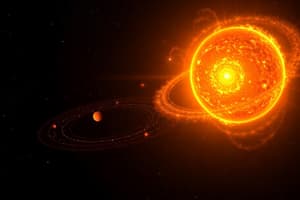Podcast
Questions and Answers
What is the stream of high-energy particles sent into space. It also causes aurora borealis and aurora australis.
What is the stream of high-energy particles sent into space. It also causes aurora borealis and aurora australis.
- prominences
- solar flares
- solar wind (correct)
- sunspots
___ are storms that look like huge arches and may last for several days
___ are storms that look like huge arches and may last for several days
Prominences
____ are more intense than prominences and lasts for about 15 minutes.
____ are more intense than prominences and lasts for about 15 minutes.
solar flares
What are cool black storm areas in the sun?
What are cool black storm areas in the sun?
Where does the energy of the sun come from?
Where does the energy of the sun come from?
How much larger is the diameter of the Sun in comparison to the Earth's?
How much larger is the diameter of the Sun in comparison to the Earth's?
How many times larger/smaller is the diameter of Mars in comparison to the Earth's
How many times larger/smaller is the diameter of Mars in comparison to the Earth's
Venus's diameter is slightly larger than the Earth.
Venus's diameter is slightly larger than the Earth.
Venus is the brightest before sunrise and before sunset.
Venus is the brightest before sunrise and before sunset.
From which direction does the Venus rotate from.
From which direction does the Venus rotate from.
The moon's diameter is ___ times the Earth's.
The moon's diameter is ___ times the Earth's.
Also called the "Red Planet."
Also called the "Red Planet."
How many times larger/smaller is the diameter of Mars in comparison to the Earth's.
How many times larger/smaller is the diameter of Mars in comparison to the Earth's.
Also considered as "minor planets."
Also considered as "minor planets."
How much larger is the diameter of Jupiter in comparison to the Earth.
How much larger is the diameter of Jupiter in comparison to the Earth.
How much larger is the diameter of Saturn in comparison to the Earth.
How much larger is the diameter of Saturn in comparison to the Earth.
How much larger is the diameter of Uranus in comparison to the Earth.
How much larger is the diameter of Uranus in comparison to the Earth.
In what direction does the planet Uranus rotate.
In what direction does the planet Uranus rotate.
How much larger is the diameter of Neptune in comparison to the Earth.
How much larger is the diameter of Neptune in comparison to the Earth.
How much smaller is the diameter of Pluto in comparison to the Earth.
How much smaller is the diameter of Pluto in comparison to the Earth.
In the sun, where is the site of nuclear fusion?
In the sun, where is the site of nuclear fusion?
What layer of the sun do we see?
What layer of the sun do we see?
What layer of the Earth is visible during solar eclipses? It is known for its reddish color. (second layer of a star's atmosphere)
What layer of the Earth is visible during solar eclipses? It is known for its reddish color. (second layer of a star's atmosphere)
The layer just outside of the Sun's core. Photons of light carry the energy created through nuclear fusion reactions in the Sun's core toward the surface as thermal radiation
The layer just outside of the Sun's core. Photons of light carry the energy created through nuclear fusion reactions in the Sun's core toward the surface as thermal radiation
The outermost, hottest part of its atmosphere, a region of plasma that is normally invisible due to the brightness of the sun's surface.
The outermost, hottest part of its atmosphere, a region of plasma that is normally invisible due to the brightness of the sun's surface.
A region within a star, like the Sun, where energy is transported outwards through the movement of hot plasma, rather than through radiation
A region within a star, like the Sun, where energy is transported outwards through the movement of hot plasma, rather than through radiation
Flashcards
Solar wind
Solar wind
A stream of high-energy particles ejected from the sun into space, causing phenomena like the aurora borealis and aurora australis.
Prominences
Prominences
Large, arch-like structures of plasma extending from the Sun's surface, lasting for days.
Solar flares
Solar flares
Sudden, intense bursts of energy released from the Sun, lasting about 15 minutes.
Sunspots
Sunspots
Signup and view all the flashcards
Nuclear fusion
Nuclear fusion
Signup and view all the flashcards
Sun's diameter vs Earth's
Sun's diameter vs Earth's
Signup and view all the flashcards
Mars' diameter vs Earth's
Mars' diameter vs Earth's
Signup and view all the flashcards
Venus' diameter vs Earth's
Venus' diameter vs Earth's
Signup and view all the flashcards
Venus visibility times
Venus visibility times
Signup and view all the flashcards
Venus rotation direction
Venus rotation direction
Signup and view all the flashcards



